An Analysis of Public Health's Role in UK Health and Social Care
VerifiedAdded on 2023/04/04
|20
|5236
|170
Report
AI Summary
This report examines the critical role of public health within the UK's healthcare system. It begins by outlining the functions of various agencies involved in identifying and managing disease levels within communities, including the NHS, government bodies, and international organizations like the WHO. The report then delves into the epidemiology of infectious and non-infectious diseases prevalent in the UK, using statistical data to highlight the impact of conditions like HIV/AIDS and diabetes. Strategies for disease management, such as surveillance, screening, isolation, and immunization are analyzed for their effectiveness. Furthermore, the report explores approaches and priorities for providing healthcare support, emphasizing disease prevention, health promotion, and educational initiatives. The report also discusses the implications of various diseases and illnesses on healthcare service provision, with a focus on how these challenges are addressed through research, policy, and community-based interventions. Overall, the report aims to provide a comprehensive understanding of public health's contributions to health and social care in the UK.

THE ROLE OF PUBLIC HEALTH IN HEALTH AND SOCIAL
CARE
CARE
Paraphrase This Document
Need a fresh take? Get an instant paraphrase of this document with our AI Paraphraser

Table of Contents
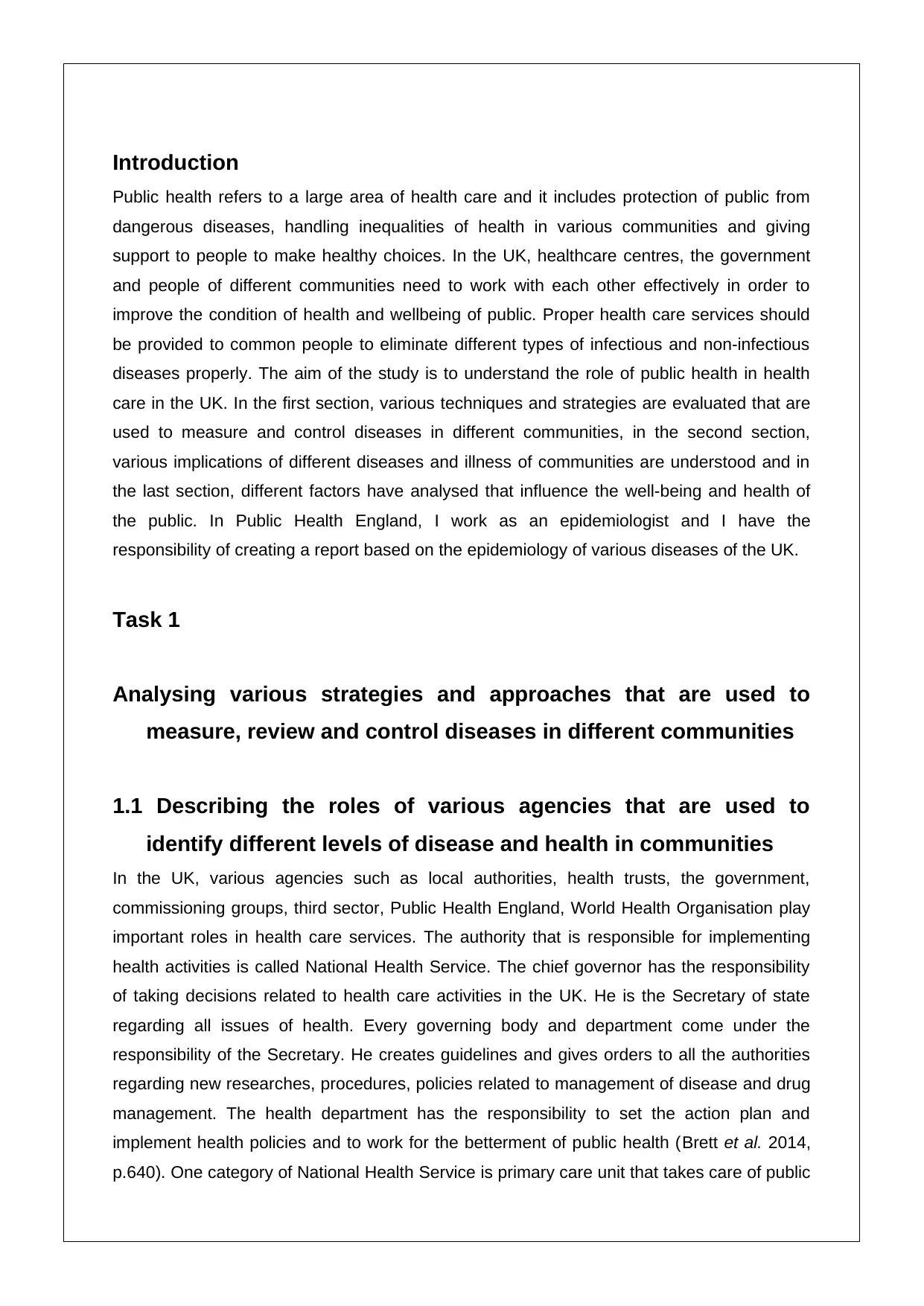
Introduction
Public health refers to a large area of health care and it includes protection of public from
dangerous diseases, handling inequalities of health in various communities and giving
support to people to make healthy choices. In the UK, healthcare centres, the government
and people of different communities need to work with each other effectively in order to
improve the condition of health and wellbeing of public. Proper health care services should
be provided to common people to eliminate different types of infectious and non-infectious
diseases properly. The aim of the study is to understand the role of public health in health
care in the UK. In the first section, various techniques and strategies are evaluated that are
used to measure and control diseases in different communities, in the second section,
various implications of different diseases and illness of communities are understood and in
the last section, different factors have analysed that influence the well-being and health of
the public. In Public Health England, I work as an epidemiologist and I have the
responsibility of creating a report based on the epidemiology of various diseases of the UK.
Task 1
Analysing various strategies and approaches that are used to
measure, review and control diseases in different communities
1.1 Describing the roles of various agencies that are used to
identify different levels of disease and health in communities
In the UK, various agencies such as local authorities, health trusts, the government,
commissioning groups, third sector, Public Health England, World Health Organisation play
important roles in health care services. The authority that is responsible for implementing
health activities is called National Health Service. The chief governor has the responsibility
of taking decisions related to health care activities in the UK. He is the Secretary of state
regarding all issues of health. Every governing body and department come under the
responsibility of the Secretary. He creates guidelines and gives orders to all the authorities
regarding new researches, procedures, policies related to management of disease and drug
management. The health department has the responsibility to set the action plan and
implement health policies and to work for the betterment of public health (Brett et al. 2014,
p.640). One category of National Health Service is primary care unit that takes care of public
Public health refers to a large area of health care and it includes protection of public from
dangerous diseases, handling inequalities of health in various communities and giving
support to people to make healthy choices. In the UK, healthcare centres, the government
and people of different communities need to work with each other effectively in order to
improve the condition of health and wellbeing of public. Proper health care services should
be provided to common people to eliminate different types of infectious and non-infectious
diseases properly. The aim of the study is to understand the role of public health in health
care in the UK. In the first section, various techniques and strategies are evaluated that are
used to measure and control diseases in different communities, in the second section,
various implications of different diseases and illness of communities are understood and in
the last section, different factors have analysed that influence the well-being and health of
the public. In Public Health England, I work as an epidemiologist and I have the
responsibility of creating a report based on the epidemiology of various diseases of the UK.
Task 1
Analysing various strategies and approaches that are used to
measure, review and control diseases in different communities
1.1 Describing the roles of various agencies that are used to
identify different levels of disease and health in communities
In the UK, various agencies such as local authorities, health trusts, the government,
commissioning groups, third sector, Public Health England, World Health Organisation play
important roles in health care services. The authority that is responsible for implementing
health activities is called National Health Service. The chief governor has the responsibility
of taking decisions related to health care activities in the UK. He is the Secretary of state
regarding all issues of health. Every governing body and department come under the
responsibility of the Secretary. He creates guidelines and gives orders to all the authorities
regarding new researches, procedures, policies related to management of disease and drug
management. The health department has the responsibility to set the action plan and
implement health policies and to work for the betterment of public health (Brett et al. 2014,
p.640). One category of National Health Service is primary care unit that takes care of public
⊘ This is a preview!⊘
Do you want full access?
Subscribe today to unlock all pages.

Trusted by 1+ million students worldwide
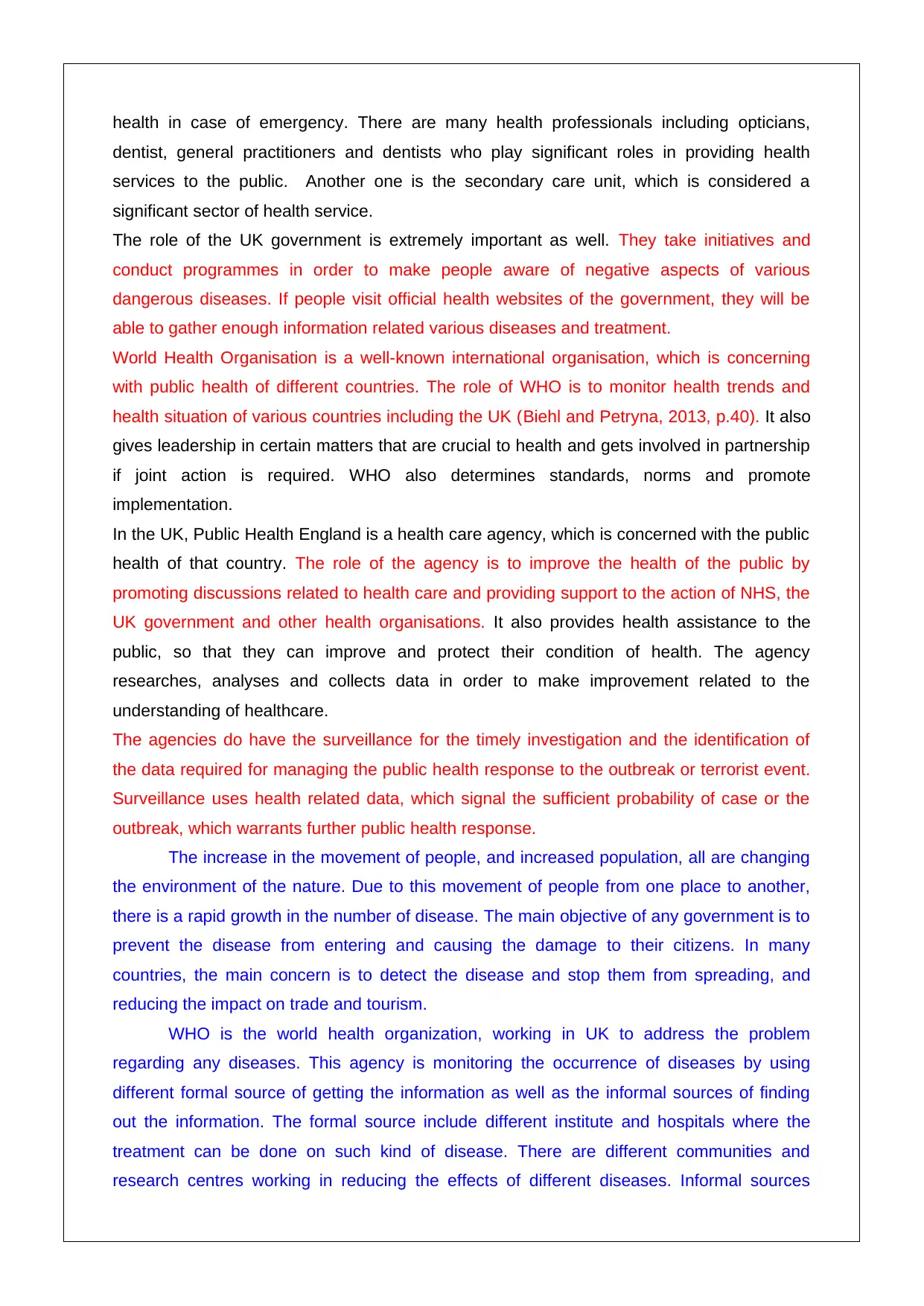
health in case of emergency. There are many health professionals including opticians,
dentist, general practitioners and dentists who play significant roles in providing health
services to the public. Another one is the secondary care unit, which is considered a
significant sector of health service.
The role of the UK government is extremely important as well. They take initiatives and
conduct programmes in order to make people aware of negative aspects of various
dangerous diseases. If people visit official health websites of the government, they will be
able to gather enough information related various diseases and treatment.
World Health Organisation is a well-known international organisation, which is concerning
with public health of different countries. The role of WHO is to monitor health trends and
health situation of various countries including the UK (Biehl and Petryna, 2013, p.40). It also
gives leadership in certain matters that are crucial to health and gets involved in partnership
if joint action is required. WHO also determines standards, norms and promote
implementation.
In the UK, Public Health England is a health care agency, which is concerned with the public
health of that country. The role of the agency is to improve the health of the public by
promoting discussions related to health care and providing support to the action of NHS, the
UK government and other health organisations. It also provides health assistance to the
public, so that they can improve and protect their condition of health. The agency
researches, analyses and collects data in order to make improvement related to the
understanding of healthcare.
The agencies do have the surveillance for the timely investigation and the identification of
the data required for managing the public health response to the outbreak or terrorist event.
Surveillance uses health related data, which signal the sufficient probability of case or the
outbreak, which warrants further public health response.
The increase in the movement of people, and increased population, all are changing
the environment of the nature. Due to this movement of people from one place to another,
there is a rapid growth in the number of disease. The main objective of any government is to
prevent the disease from entering and causing the damage to their citizens. In many
countries, the main concern is to detect the disease and stop them from spreading, and
reducing the impact on trade and tourism.
WHO is the world health organization, working in UK to address the problem
regarding any diseases. This agency is monitoring the occurrence of diseases by using
different formal source of getting the information as well as the informal sources of finding
out the information. The formal source include different institute and hospitals where the
treatment can be done on such kind of disease. There are different communities and
research centres working in reducing the effects of different diseases. Informal sources
dentist, general practitioners and dentists who play significant roles in providing health
services to the public. Another one is the secondary care unit, which is considered a
significant sector of health service.
The role of the UK government is extremely important as well. They take initiatives and
conduct programmes in order to make people aware of negative aspects of various
dangerous diseases. If people visit official health websites of the government, they will be
able to gather enough information related various diseases and treatment.
World Health Organisation is a well-known international organisation, which is concerning
with public health of different countries. The role of WHO is to monitor health trends and
health situation of various countries including the UK (Biehl and Petryna, 2013, p.40). It also
gives leadership in certain matters that are crucial to health and gets involved in partnership
if joint action is required. WHO also determines standards, norms and promote
implementation.
In the UK, Public Health England is a health care agency, which is concerned with the public
health of that country. The role of the agency is to improve the health of the public by
promoting discussions related to health care and providing support to the action of NHS, the
UK government and other health organisations. It also provides health assistance to the
public, so that they can improve and protect their condition of health. The agency
researches, analyses and collects data in order to make improvement related to the
understanding of healthcare.
The agencies do have the surveillance for the timely investigation and the identification of
the data required for managing the public health response to the outbreak or terrorist event.
Surveillance uses health related data, which signal the sufficient probability of case or the
outbreak, which warrants further public health response.
The increase in the movement of people, and increased population, all are changing
the environment of the nature. Due to this movement of people from one place to another,
there is a rapid growth in the number of disease. The main objective of any government is to
prevent the disease from entering and causing the damage to their citizens. In many
countries, the main concern is to detect the disease and stop them from spreading, and
reducing the impact on trade and tourism.
WHO is the world health organization, working in UK to address the problem
regarding any diseases. This agency is monitoring the occurrence of diseases by using
different formal source of getting the information as well as the informal sources of finding
out the information. The formal source include different institute and hospitals where the
treatment can be done on such kind of disease. There are different communities and
research centres working in reducing the effects of different diseases. Informal sources
Paraphrase This Document
Need a fresh take? Get an instant paraphrase of this document with our AI Paraphraser
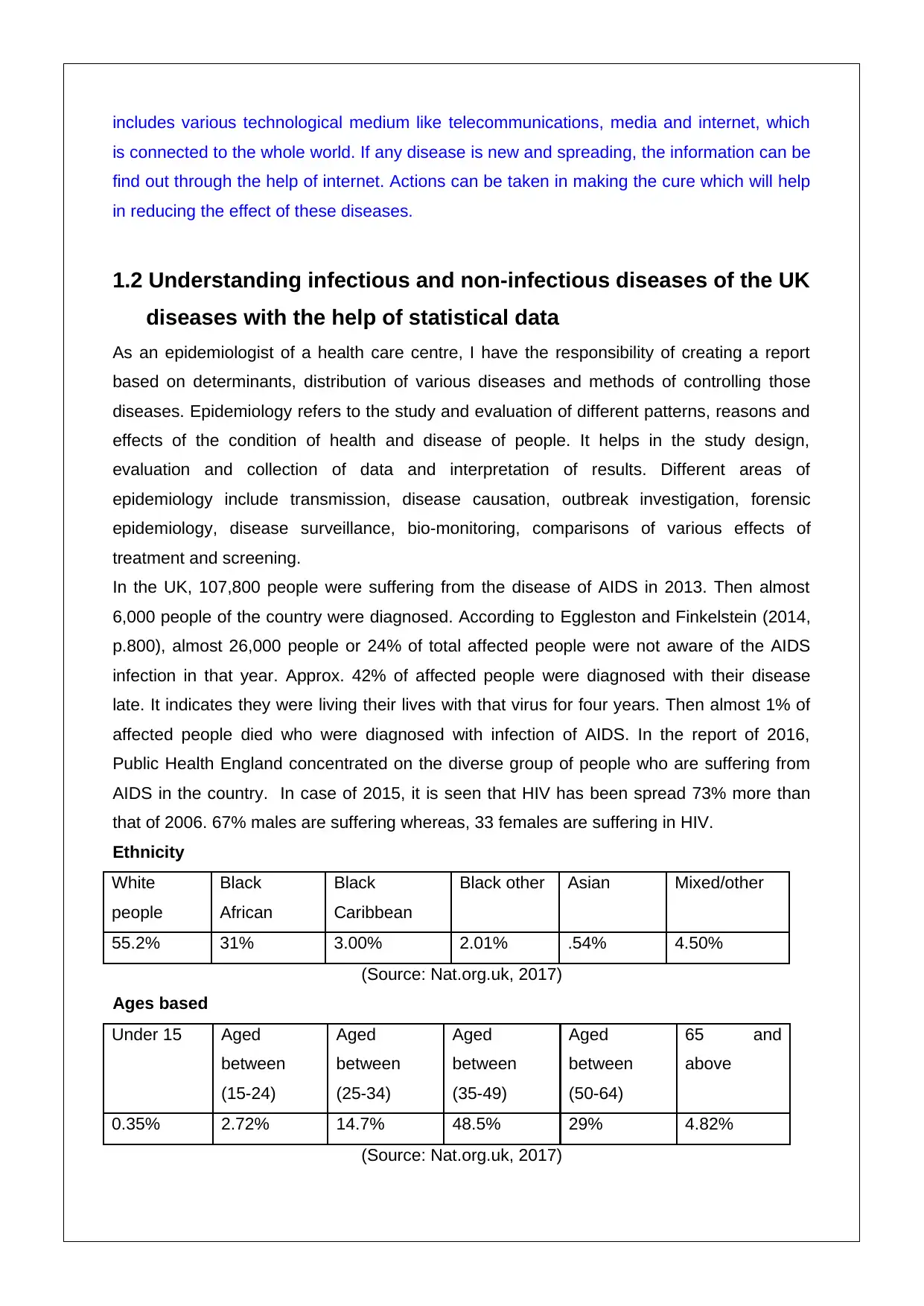
includes various technological medium like telecommunications, media and internet, which
is connected to the whole world. If any disease is new and spreading, the information can be
find out through the help of internet. Actions can be taken in making the cure which will help
in reducing the effect of these diseases.
1.2 Understanding infectious and non-infectious diseases of the UK
diseases with the help of statistical data
As an epidemiologist of a health care centre, I have the responsibility of creating a report
based on determinants, distribution of various diseases and methods of controlling those
diseases. Epidemiology refers to the study and evaluation of different patterns, reasons and
effects of the condition of health and disease of people. It helps in the study design,
evaluation and collection of data and interpretation of results. Different areas of
epidemiology include transmission, disease causation, outbreak investigation, forensic
epidemiology, disease surveillance, bio-monitoring, comparisons of various effects of
treatment and screening.
In the UK, 107,800 people were suffering from the disease of AIDS in 2013. Then almost
6,000 people of the country were diagnosed. According to Eggleston and Finkelstein (2014,
p.800), almost 26,000 people or 24% of total affected people were not aware of the AIDS
infection in that year. Approx. 42% of affected people were diagnosed with their disease
late. It indicates they were living their lives with that virus for four years. Then almost 1% of
affected people died who were diagnosed with infection of AIDS. In the report of 2016,
Public Health England concentrated on the diverse group of people who are suffering from
AIDS in the country. In case of 2015, it is seen that HIV has been spread 73% more than
that of 2006. 67% males are suffering whereas, 33 females are suffering in HIV.
Ethnicity
White
people
Black
African
Black
Caribbean
Black other Asian Mixed/other
55.2% 31% 3.00% 2.01% .54% 4.50%
(Source: Nat.org.uk, 2017)
Ages based
Under 15 Aged
between
(15-24)
Aged
between
(25-34)
Aged
between
(35-49)
Aged
between
(50-64)
65 and
above
0.35% 2.72% 14.7% 48.5% 29% 4.82%
(Source: Nat.org.uk, 2017)
is connected to the whole world. If any disease is new and spreading, the information can be
find out through the help of internet. Actions can be taken in making the cure which will help
in reducing the effect of these diseases.
1.2 Understanding infectious and non-infectious diseases of the UK
diseases with the help of statistical data
As an epidemiologist of a health care centre, I have the responsibility of creating a report
based on determinants, distribution of various diseases and methods of controlling those
diseases. Epidemiology refers to the study and evaluation of different patterns, reasons and
effects of the condition of health and disease of people. It helps in the study design,
evaluation and collection of data and interpretation of results. Different areas of
epidemiology include transmission, disease causation, outbreak investigation, forensic
epidemiology, disease surveillance, bio-monitoring, comparisons of various effects of
treatment and screening.
In the UK, 107,800 people were suffering from the disease of AIDS in 2013. Then almost
6,000 people of the country were diagnosed. According to Eggleston and Finkelstein (2014,
p.800), almost 26,000 people or 24% of total affected people were not aware of the AIDS
infection in that year. Approx. 42% of affected people were diagnosed with their disease
late. It indicates they were living their lives with that virus for four years. Then almost 1% of
affected people died who were diagnosed with infection of AIDS. In the report of 2016,
Public Health England concentrated on the diverse group of people who are suffering from
AIDS in the country. In case of 2015, it is seen that HIV has been spread 73% more than
that of 2006. 67% males are suffering whereas, 33 females are suffering in HIV.
Ethnicity
White
people
Black
African
Black
Caribbean
Black other Asian Mixed/other
55.2% 31% 3.00% 2.01% .54% 4.50%
(Source: Nat.org.uk, 2017)
Ages based
Under 15 Aged
between
(15-24)
Aged
between
(25-34)
Aged
between
(35-49)
Aged
between
(50-64)
65 and
above
0.35% 2.72% 14.7% 48.5% 29% 4.82%
(Source: Nat.org.uk, 2017)
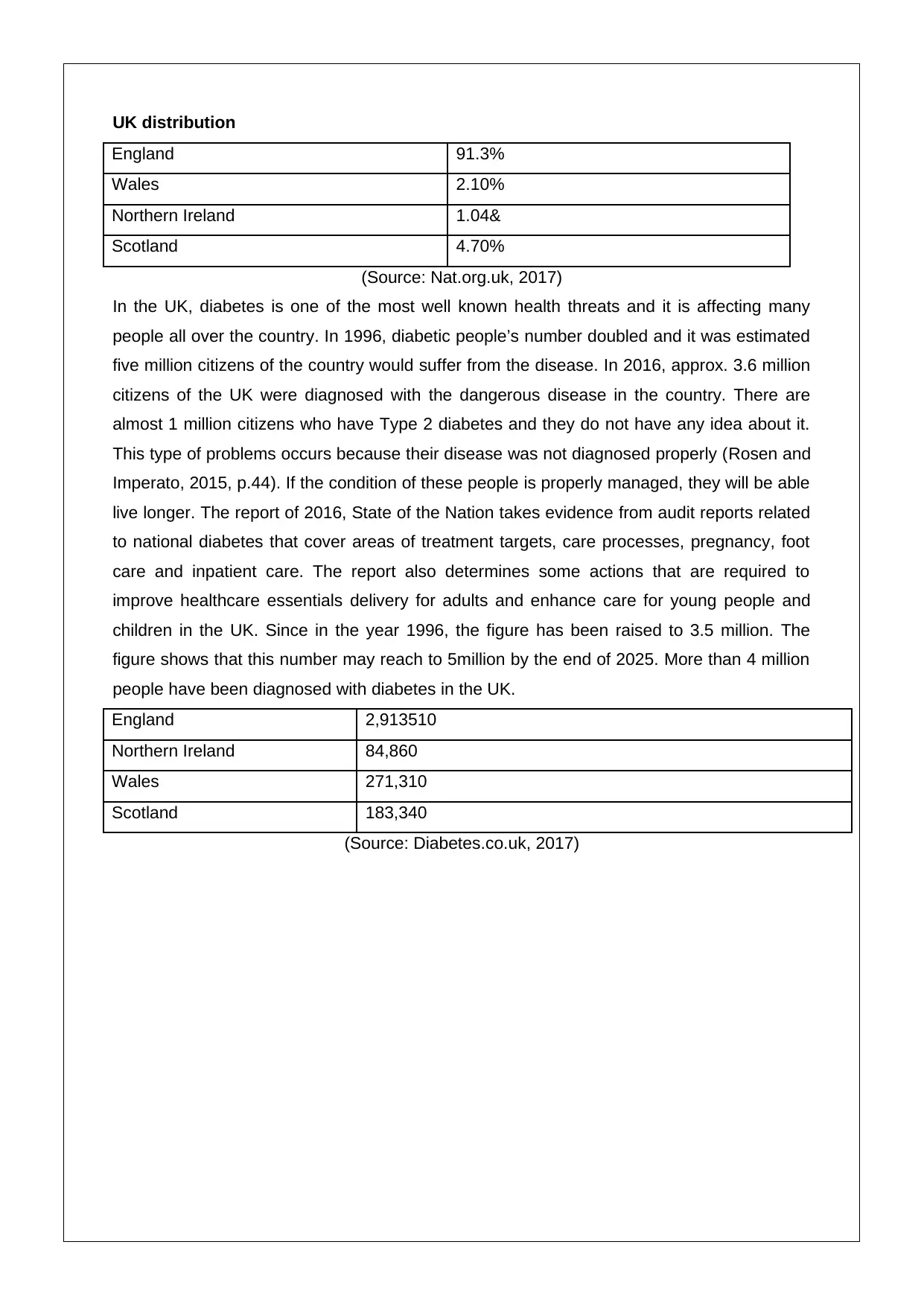
UK distribution
England 91.3%
Wales 2.10%
Northern Ireland 1.04&
Scotland 4.70%
(Source: Nat.org.uk, 2017)
In the UK, diabetes is one of the most well known health threats and it is affecting many
people all over the country. In 1996, diabetic people’s number doubled and it was estimated
five million citizens of the country would suffer from the disease. In 2016, approx. 3.6 million
citizens of the UK were diagnosed with the dangerous disease in the country. There are
almost 1 million citizens who have Type 2 diabetes and they do not have any idea about it.
This type of problems occurs because their disease was not diagnosed properly (Rosen and
Imperato, 2015, p.44). If the condition of these people is properly managed, they will be able
live longer. The report of 2016, State of the Nation takes evidence from audit reports related
to national diabetes that cover areas of treatment targets, care processes, pregnancy, foot
care and inpatient care. The report also determines some actions that are required to
improve healthcare essentials delivery for adults and enhance care for young people and
children in the UK. Since in the year 1996, the figure has been raised to 3.5 million. The
figure shows that this number may reach to 5million by the end of 2025. More than 4 million
people have been diagnosed with diabetes in the UK.
England 2,913510
Northern Ireland 84,860
Wales 271,310
Scotland 183,340
(Source: Diabetes.co.uk, 2017)
England 91.3%
Wales 2.10%
Northern Ireland 1.04&
Scotland 4.70%
(Source: Nat.org.uk, 2017)
In the UK, diabetes is one of the most well known health threats and it is affecting many
people all over the country. In 1996, diabetic people’s number doubled and it was estimated
five million citizens of the country would suffer from the disease. In 2016, approx. 3.6 million
citizens of the UK were diagnosed with the dangerous disease in the country. There are
almost 1 million citizens who have Type 2 diabetes and they do not have any idea about it.
This type of problems occurs because their disease was not diagnosed properly (Rosen and
Imperato, 2015, p.44). If the condition of these people is properly managed, they will be able
live longer. The report of 2016, State of the Nation takes evidence from audit reports related
to national diabetes that cover areas of treatment targets, care processes, pregnancy, foot
care and inpatient care. The report also determines some actions that are required to
improve healthcare essentials delivery for adults and enhance care for young people and
children in the UK. Since in the year 1996, the figure has been raised to 3.5 million. The
figure shows that this number may reach to 5million by the end of 2025. More than 4 million
people have been diagnosed with diabetes in the UK.
England 2,913510
Northern Ireland 84,860
Wales 271,310
Scotland 183,340
(Source: Diabetes.co.uk, 2017)
⊘ This is a preview!⊘
Do you want full access?
Subscribe today to unlock all pages.

Trusted by 1+ million students worldwide

Paraphrase This Document
Need a fresh take? Get an instant paraphrase of this document with our AI Paraphraser
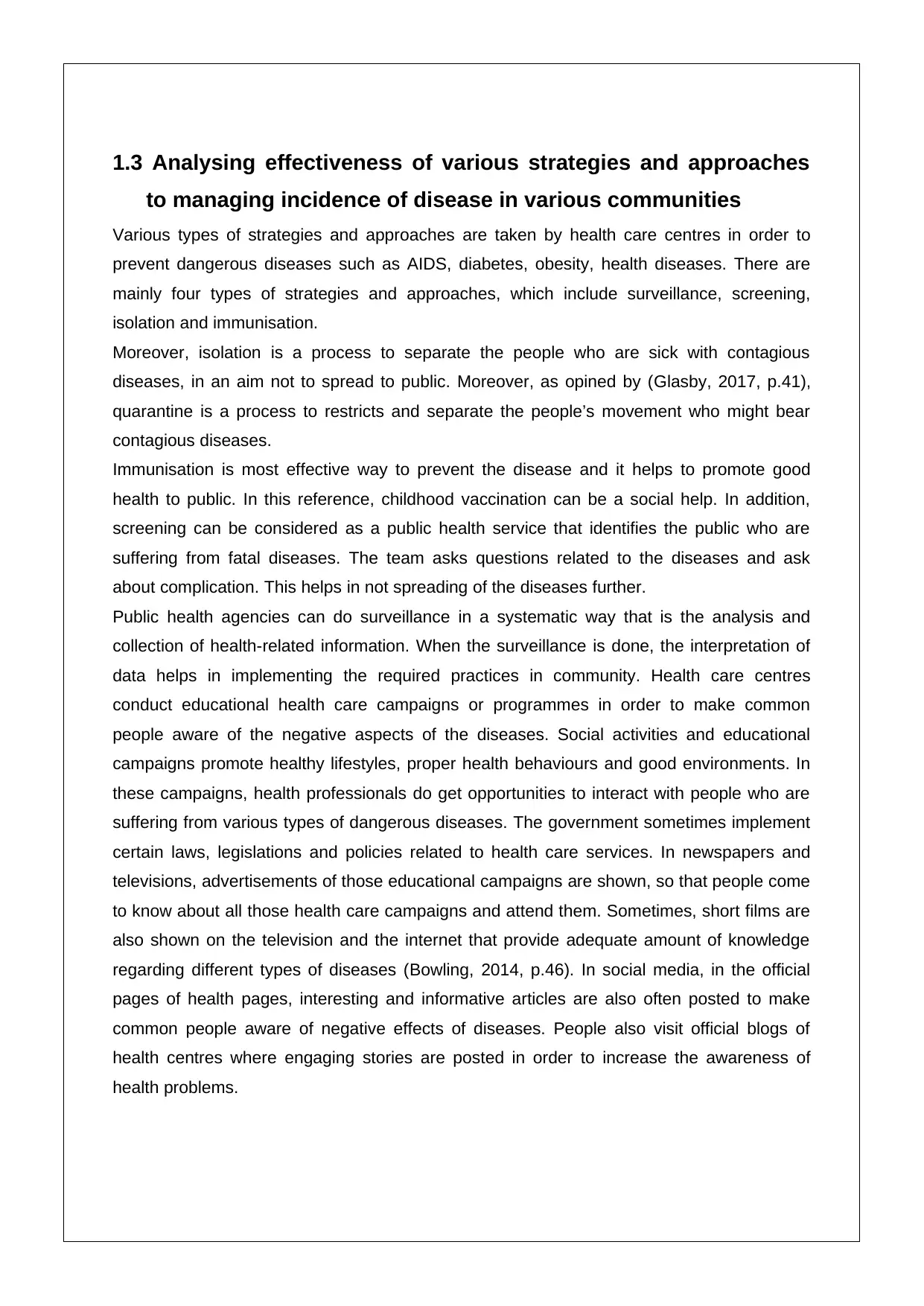
1.3 Analysing effectiveness of various strategies and approaches
to managing incidence of disease in various communities
Various types of strategies and approaches are taken by health care centres in order to
prevent dangerous diseases such as AIDS, diabetes, obesity, health diseases. There are
mainly four types of strategies and approaches, which include surveillance, screening,
isolation and immunisation.
Moreover, isolation is a process to separate the people who are sick with contagious
diseases, in an aim not to spread to public. Moreover, as opined by (Glasby, 2017, p.41),
quarantine is a process to restricts and separate the people’s movement who might bear
contagious diseases.
Immunisation is most effective way to prevent the disease and it helps to promote good
health to public. In this reference, childhood vaccination can be a social help. In addition,
screening can be considered as a public health service that identifies the public who are
suffering from fatal diseases. The team asks questions related to the diseases and ask
about complication. This helps in not spreading of the diseases further.
Public health agencies can do surveillance in a systematic way that is the analysis and
collection of health-related information. When the surveillance is done, the interpretation of
data helps in implementing the required practices in community. Health care centres
conduct educational health care campaigns or programmes in order to make common
people aware of the negative aspects of the diseases. Social activities and educational
campaigns promote healthy lifestyles, proper health behaviours and good environments. In
these campaigns, health professionals do get opportunities to interact with people who are
suffering from various types of dangerous diseases. The government sometimes implement
certain laws, legislations and policies related to health care services. In newspapers and
televisions, advertisements of those educational campaigns are shown, so that people come
to know about all those health care campaigns and attend them. Sometimes, short films are
also shown on the television and the internet that provide adequate amount of knowledge
regarding different types of diseases (Bowling, 2014, p.46). In social media, in the official
pages of health pages, interesting and informative articles are also often posted to make
common people aware of negative effects of diseases. People also visit official blogs of
health centres where engaging stories are posted in order to increase the awareness of
health problems.
to managing incidence of disease in various communities
Various types of strategies and approaches are taken by health care centres in order to
prevent dangerous diseases such as AIDS, diabetes, obesity, health diseases. There are
mainly four types of strategies and approaches, which include surveillance, screening,
isolation and immunisation.
Moreover, isolation is a process to separate the people who are sick with contagious
diseases, in an aim not to spread to public. Moreover, as opined by (Glasby, 2017, p.41),
quarantine is a process to restricts and separate the people’s movement who might bear
contagious diseases.
Immunisation is most effective way to prevent the disease and it helps to promote good
health to public. In this reference, childhood vaccination can be a social help. In addition,
screening can be considered as a public health service that identifies the public who are
suffering from fatal diseases. The team asks questions related to the diseases and ask
about complication. This helps in not spreading of the diseases further.
Public health agencies can do surveillance in a systematic way that is the analysis and
collection of health-related information. When the surveillance is done, the interpretation of
data helps in implementing the required practices in community. Health care centres
conduct educational health care campaigns or programmes in order to make common
people aware of the negative aspects of the diseases. Social activities and educational
campaigns promote healthy lifestyles, proper health behaviours and good environments. In
these campaigns, health professionals do get opportunities to interact with people who are
suffering from various types of dangerous diseases. The government sometimes implement
certain laws, legislations and policies related to health care services. In newspapers and
televisions, advertisements of those educational campaigns are shown, so that people come
to know about all those health care campaigns and attend them. Sometimes, short films are
also shown on the television and the internet that provide adequate amount of knowledge
regarding different types of diseases (Bowling, 2014, p.46). In social media, in the official
pages of health pages, interesting and informative articles are also often posted to make
common people aware of negative effects of diseases. People also visit official blogs of
health centres where engaging stories are posted in order to increase the awareness of
health problems.
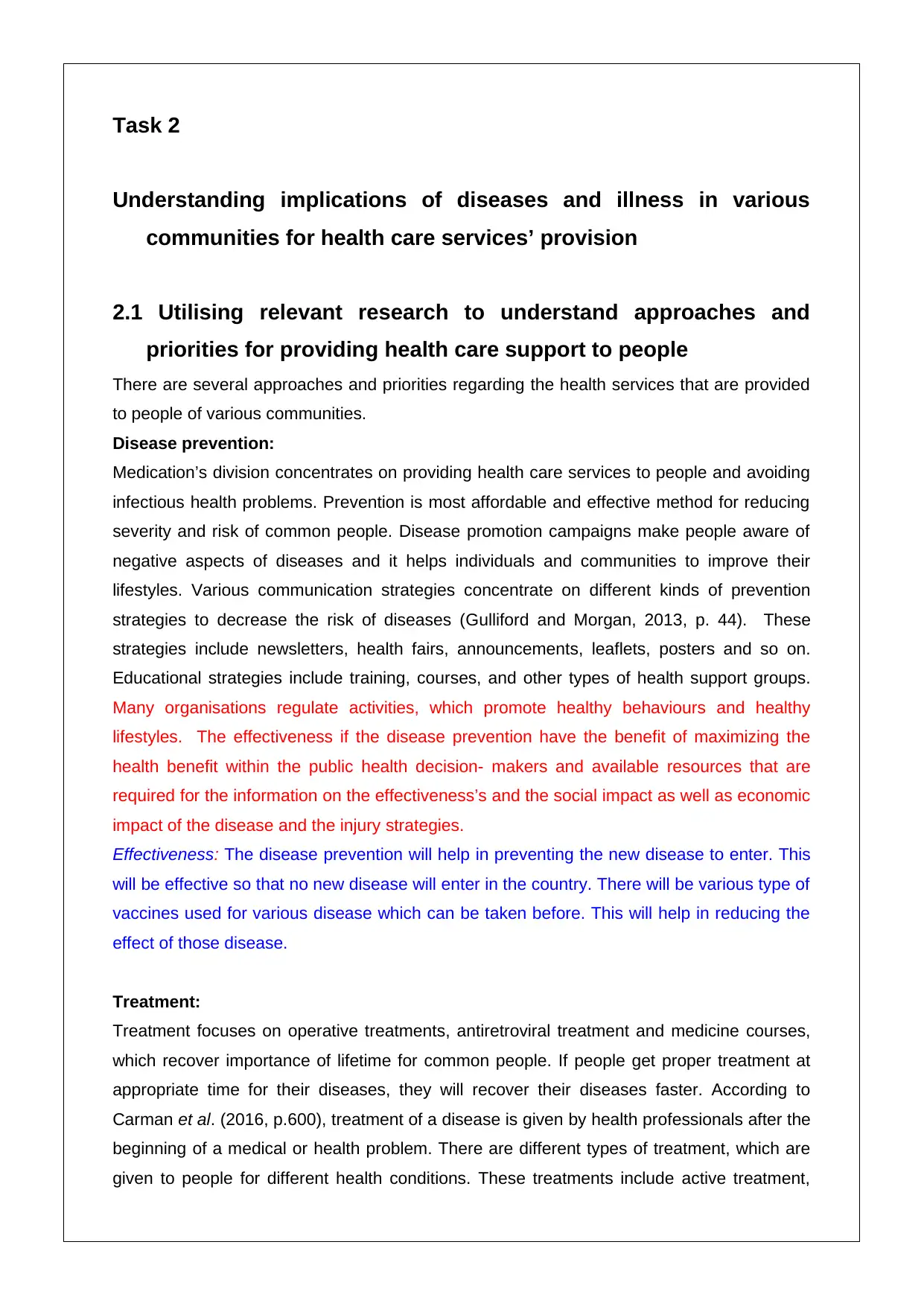
Task 2
Understanding implications of diseases and illness in various
communities for health care services’ provision
2.1 Utilising relevant research to understand approaches and
priorities for providing health care support to people
There are several approaches and priorities regarding the health services that are provided
to people of various communities.
Disease prevention:
Medication’s division concentrates on providing health care services to people and avoiding
infectious health problems. Prevention is most affordable and effective method for reducing
severity and risk of common people. Disease promotion campaigns make people aware of
negative aspects of diseases and it helps individuals and communities to improve their
lifestyles. Various communication strategies concentrate on different kinds of prevention
strategies to decrease the risk of diseases (Gulliford and Morgan, 2013, p. 44). These
strategies include newsletters, health fairs, announcements, leaflets, posters and so on.
Educational strategies include training, courses, and other types of health support groups.
Many organisations regulate activities, which promote healthy behaviours and healthy
lifestyles. The effectiveness if the disease prevention have the benefit of maximizing the
health benefit within the public health decision- makers and available resources that are
required for the information on the effectiveness’s and the social impact as well as economic
impact of the disease and the injury strategies.
Effectiveness: The disease prevention will help in preventing the new disease to enter. This
will be effective so that no new disease will enter in the country. There will be various type of
vaccines used for various disease which can be taken before. This will help in reducing the
effect of those disease.
Treatment:
Treatment focuses on operative treatments, antiretroviral treatment and medicine courses,
which recover importance of lifetime for common people. If people get proper treatment at
appropriate time for their diseases, they will recover their diseases faster. According to
Carman et al. (2016, p.600), treatment of a disease is given by health professionals after the
beginning of a medical or health problem. There are different types of treatment, which are
given to people for different health conditions. These treatments include active treatment,
Understanding implications of diseases and illness in various
communities for health care services’ provision
2.1 Utilising relevant research to understand approaches and
priorities for providing health care support to people
There are several approaches and priorities regarding the health services that are provided
to people of various communities.
Disease prevention:
Medication’s division concentrates on providing health care services to people and avoiding
infectious health problems. Prevention is most affordable and effective method for reducing
severity and risk of common people. Disease promotion campaigns make people aware of
negative aspects of diseases and it helps individuals and communities to improve their
lifestyles. Various communication strategies concentrate on different kinds of prevention
strategies to decrease the risk of diseases (Gulliford and Morgan, 2013, p. 44). These
strategies include newsletters, health fairs, announcements, leaflets, posters and so on.
Educational strategies include training, courses, and other types of health support groups.
Many organisations regulate activities, which promote healthy behaviours and healthy
lifestyles. The effectiveness if the disease prevention have the benefit of maximizing the
health benefit within the public health decision- makers and available resources that are
required for the information on the effectiveness’s and the social impact as well as economic
impact of the disease and the injury strategies.
Effectiveness: The disease prevention will help in preventing the new disease to enter. This
will be effective so that no new disease will enter in the country. There will be various type of
vaccines used for various disease which can be taken before. This will help in reducing the
effect of those disease.
Treatment:
Treatment focuses on operative treatments, antiretroviral treatment and medicine courses,
which recover importance of lifetime for common people. If people get proper treatment at
appropriate time for their diseases, they will recover their diseases faster. According to
Carman et al. (2016, p.600), treatment of a disease is given by health professionals after the
beginning of a medical or health problem. There are different types of treatment, which are
given to people for different health conditions. These treatments include active treatment,
⊘ This is a preview!⊘
Do you want full access?
Subscribe today to unlock all pages.

Trusted by 1+ million students worldwide
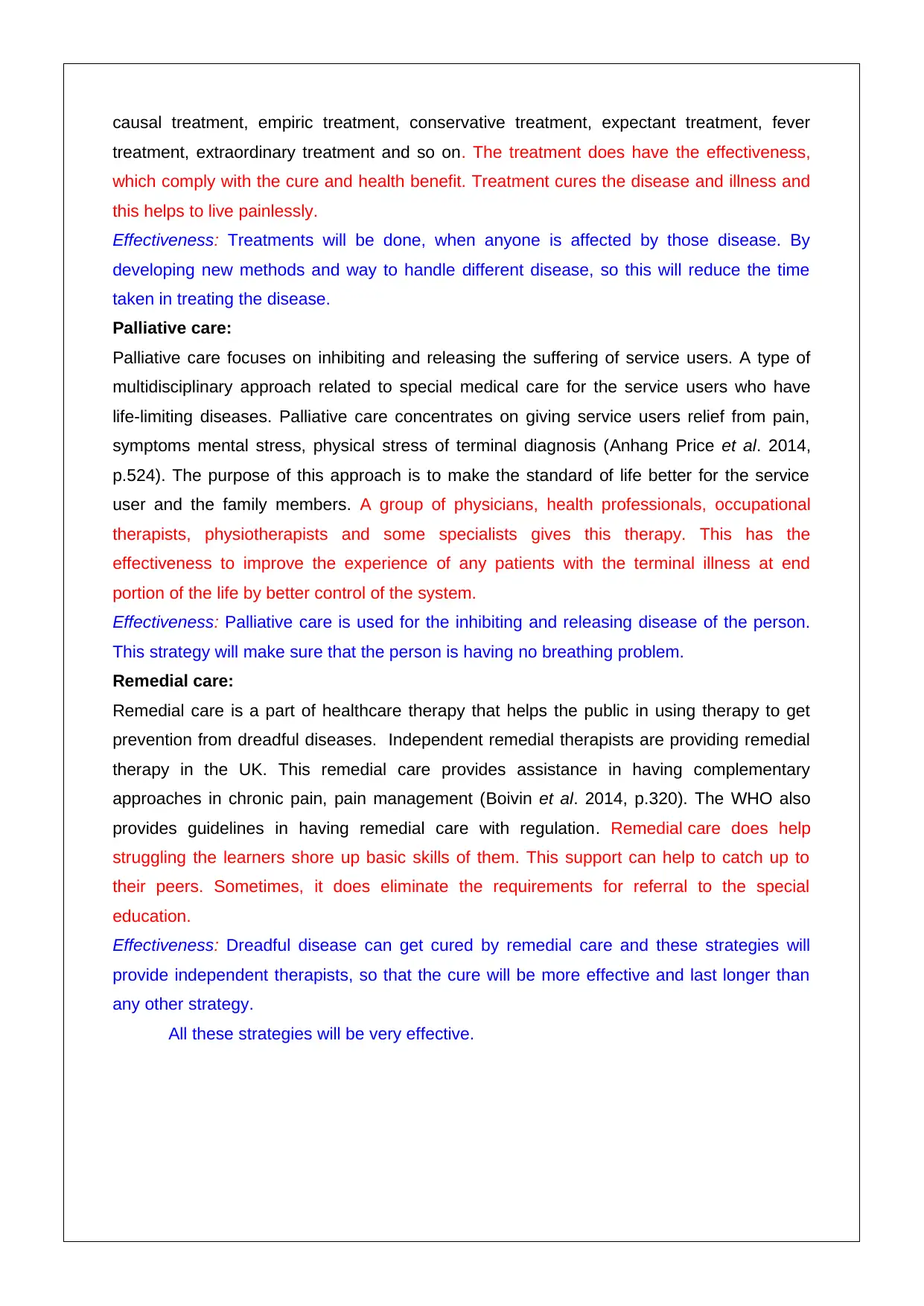
causal treatment, empiric treatment, conservative treatment, expectant treatment, fever
treatment, extraordinary treatment and so on. The treatment does have the effectiveness,
which comply with the cure and health benefit. Treatment cures the disease and illness and
this helps to live painlessly.
Effectiveness: Treatments will be done, when anyone is affected by those disease. By
developing new methods and way to handle different disease, so this will reduce the time
taken in treating the disease.
Palliative care:
Palliative care focuses on inhibiting and releasing the suffering of service users. A type of
multidisciplinary approach related to special medical care for the service users who have
life-limiting diseases. Palliative care concentrates on giving service users relief from pain,
symptoms mental stress, physical stress of terminal diagnosis (Anhang Price et al. 2014,
p.524). The purpose of this approach is to make the standard of life better for the service
user and the family members. A group of physicians, health professionals, occupational
therapists, physiotherapists and some specialists gives this therapy. This has the
effectiveness to improve the experience of any patients with the terminal illness at end
portion of the life by better control of the system.
Effectiveness: Palliative care is used for the inhibiting and releasing disease of the person.
This strategy will make sure that the person is having no breathing problem.
Remedial care:
Remedial care is a part of healthcare therapy that helps the public in using therapy to get
prevention from dreadful diseases. Independent remedial therapists are providing remedial
therapy in the UK. This remedial care provides assistance in having complementary
approaches in chronic pain, pain management (Boivin et al. 2014, p.320). The WHO also
provides guidelines in having remedial care with regulation. Remedial care does help
struggling the learners shore up basic skills of them. This support can help to catch up to
their peers. Sometimes, it does eliminate the requirements for referral to the special
education.
Effectiveness: Dreadful disease can get cured by remedial care and these strategies will
provide independent therapists, so that the cure will be more effective and last longer than
any other strategy.
All these strategies will be very effective.
treatment, extraordinary treatment and so on. The treatment does have the effectiveness,
which comply with the cure and health benefit. Treatment cures the disease and illness and
this helps to live painlessly.
Effectiveness: Treatments will be done, when anyone is affected by those disease. By
developing new methods and way to handle different disease, so this will reduce the time
taken in treating the disease.
Palliative care:
Palliative care focuses on inhibiting and releasing the suffering of service users. A type of
multidisciplinary approach related to special medical care for the service users who have
life-limiting diseases. Palliative care concentrates on giving service users relief from pain,
symptoms mental stress, physical stress of terminal diagnosis (Anhang Price et al. 2014,
p.524). The purpose of this approach is to make the standard of life better for the service
user and the family members. A group of physicians, health professionals, occupational
therapists, physiotherapists and some specialists gives this therapy. This has the
effectiveness to improve the experience of any patients with the terminal illness at end
portion of the life by better control of the system.
Effectiveness: Palliative care is used for the inhibiting and releasing disease of the person.
This strategy will make sure that the person is having no breathing problem.
Remedial care:
Remedial care is a part of healthcare therapy that helps the public in using therapy to get
prevention from dreadful diseases. Independent remedial therapists are providing remedial
therapy in the UK. This remedial care provides assistance in having complementary
approaches in chronic pain, pain management (Boivin et al. 2014, p.320). The WHO also
provides guidelines in having remedial care with regulation. Remedial care does help
struggling the learners shore up basic skills of them. This support can help to catch up to
their peers. Sometimes, it does eliminate the requirements for referral to the special
education.
Effectiveness: Dreadful disease can get cured by remedial care and these strategies will
provide independent therapists, so that the cure will be more effective and last longer than
any other strategy.
All these strategies will be very effective.
Paraphrase This Document
Need a fresh take? Get an instant paraphrase of this document with our AI Paraphraser
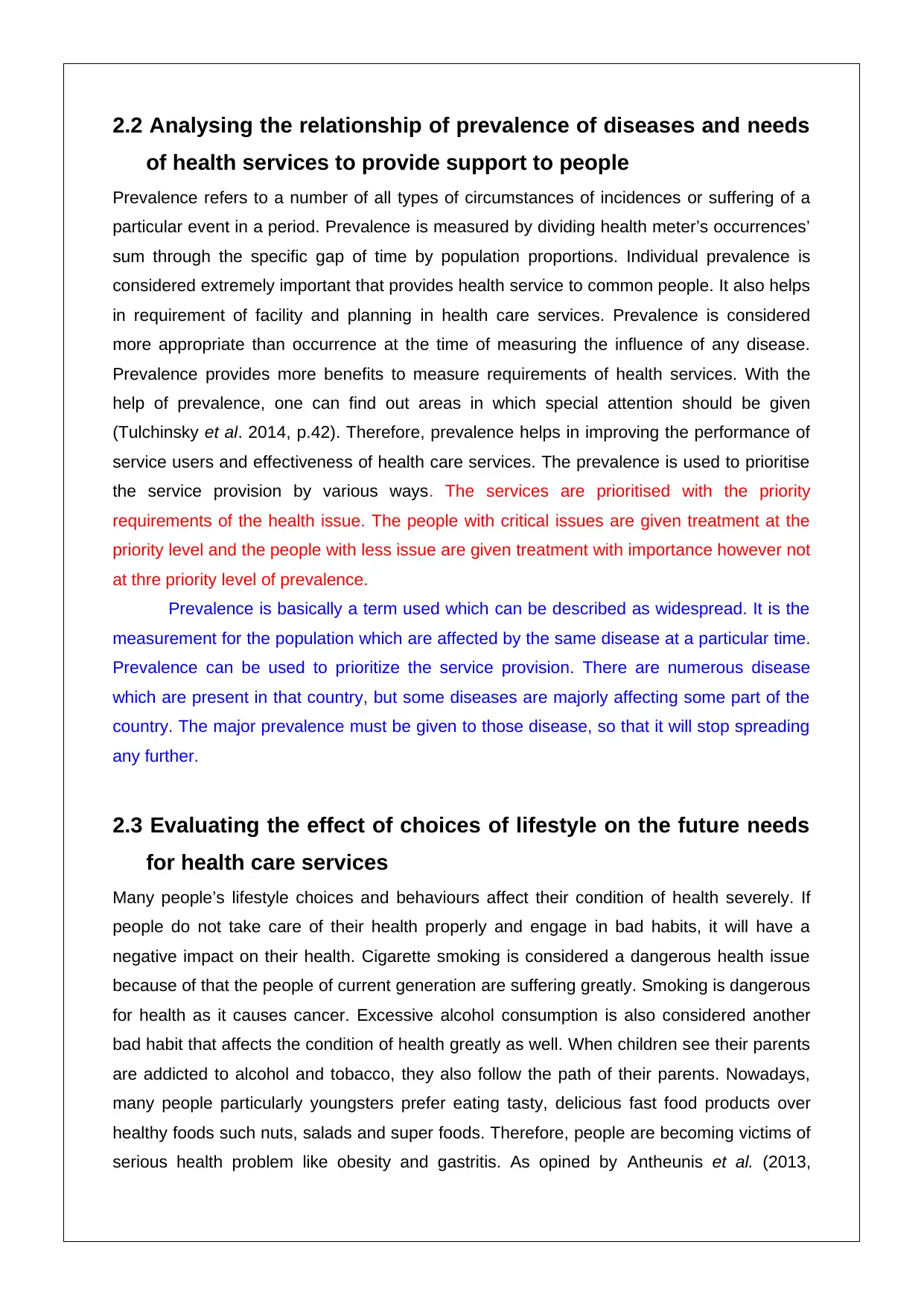
2.2 Analysing the relationship of prevalence of diseases and needs
of health services to provide support to people
Prevalence refers to a number of all types of circumstances of incidences or suffering of a
particular event in a period. Prevalence is measured by dividing health meter’s occurrences’
sum through the specific gap of time by population proportions. Individual prevalence is
considered extremely important that provides health service to common people. It also helps
in requirement of facility and planning in health care services. Prevalence is considered
more appropriate than occurrence at the time of measuring the influence of any disease.
Prevalence provides more benefits to measure requirements of health services. With the
help of prevalence, one can find out areas in which special attention should be given
(Tulchinsky et al. 2014, p.42). Therefore, prevalence helps in improving the performance of
service users and effectiveness of health care services. The prevalence is used to prioritise
the service provision by various ways. The services are prioritised with the priority
requirements of the health issue. The people with critical issues are given treatment at the
priority level and the people with less issue are given treatment with importance however not
at thre priority level of prevalence.
Prevalence is basically a term used which can be described as widespread. It is the
measurement for the population which are affected by the same disease at a particular time.
Prevalence can be used to prioritize the service provision. There are numerous disease
which are present in that country, but some diseases are majorly affecting some part of the
country. The major prevalence must be given to those disease, so that it will stop spreading
any further.
2.3 Evaluating the effect of choices of lifestyle on the future needs
for health care services
Many people’s lifestyle choices and behaviours affect their condition of health severely. If
people do not take care of their health properly and engage in bad habits, it will have a
negative impact on their health. Cigarette smoking is considered a dangerous health issue
because of that the people of current generation are suffering greatly. Smoking is dangerous
for health as it causes cancer. Excessive alcohol consumption is also considered another
bad habit that affects the condition of health greatly as well. When children see their parents
are addicted to alcohol and tobacco, they also follow the path of their parents. Nowadays,
many people particularly youngsters prefer eating tasty, delicious fast food products over
healthy foods such nuts, salads and super foods. Therefore, people are becoming victims of
serious health problem like obesity and gastritis. As opined by Antheunis et al. (2013,
of health services to provide support to people
Prevalence refers to a number of all types of circumstances of incidences or suffering of a
particular event in a period. Prevalence is measured by dividing health meter’s occurrences’
sum through the specific gap of time by population proportions. Individual prevalence is
considered extremely important that provides health service to common people. It also helps
in requirement of facility and planning in health care services. Prevalence is considered
more appropriate than occurrence at the time of measuring the influence of any disease.
Prevalence provides more benefits to measure requirements of health services. With the
help of prevalence, one can find out areas in which special attention should be given
(Tulchinsky et al. 2014, p.42). Therefore, prevalence helps in improving the performance of
service users and effectiveness of health care services. The prevalence is used to prioritise
the service provision by various ways. The services are prioritised with the priority
requirements of the health issue. The people with critical issues are given treatment at the
priority level and the people with less issue are given treatment with importance however not
at thre priority level of prevalence.
Prevalence is basically a term used which can be described as widespread. It is the
measurement for the population which are affected by the same disease at a particular time.
Prevalence can be used to prioritize the service provision. There are numerous disease
which are present in that country, but some diseases are majorly affecting some part of the
country. The major prevalence must be given to those disease, so that it will stop spreading
any further.
2.3 Evaluating the effect of choices of lifestyle on the future needs
for health care services
Many people’s lifestyle choices and behaviours affect their condition of health severely. If
people do not take care of their health properly and engage in bad habits, it will have a
negative impact on their health. Cigarette smoking is considered a dangerous health issue
because of that the people of current generation are suffering greatly. Smoking is dangerous
for health as it causes cancer. Excessive alcohol consumption is also considered another
bad habit that affects the condition of health greatly as well. When children see their parents
are addicted to alcohol and tobacco, they also follow the path of their parents. Nowadays,
many people particularly youngsters prefer eating tasty, delicious fast food products over
healthy foods such nuts, salads and super foods. Therefore, people are becoming victims of
serious health problem like obesity and gastritis. As opined by Antheunis et al. (2013,
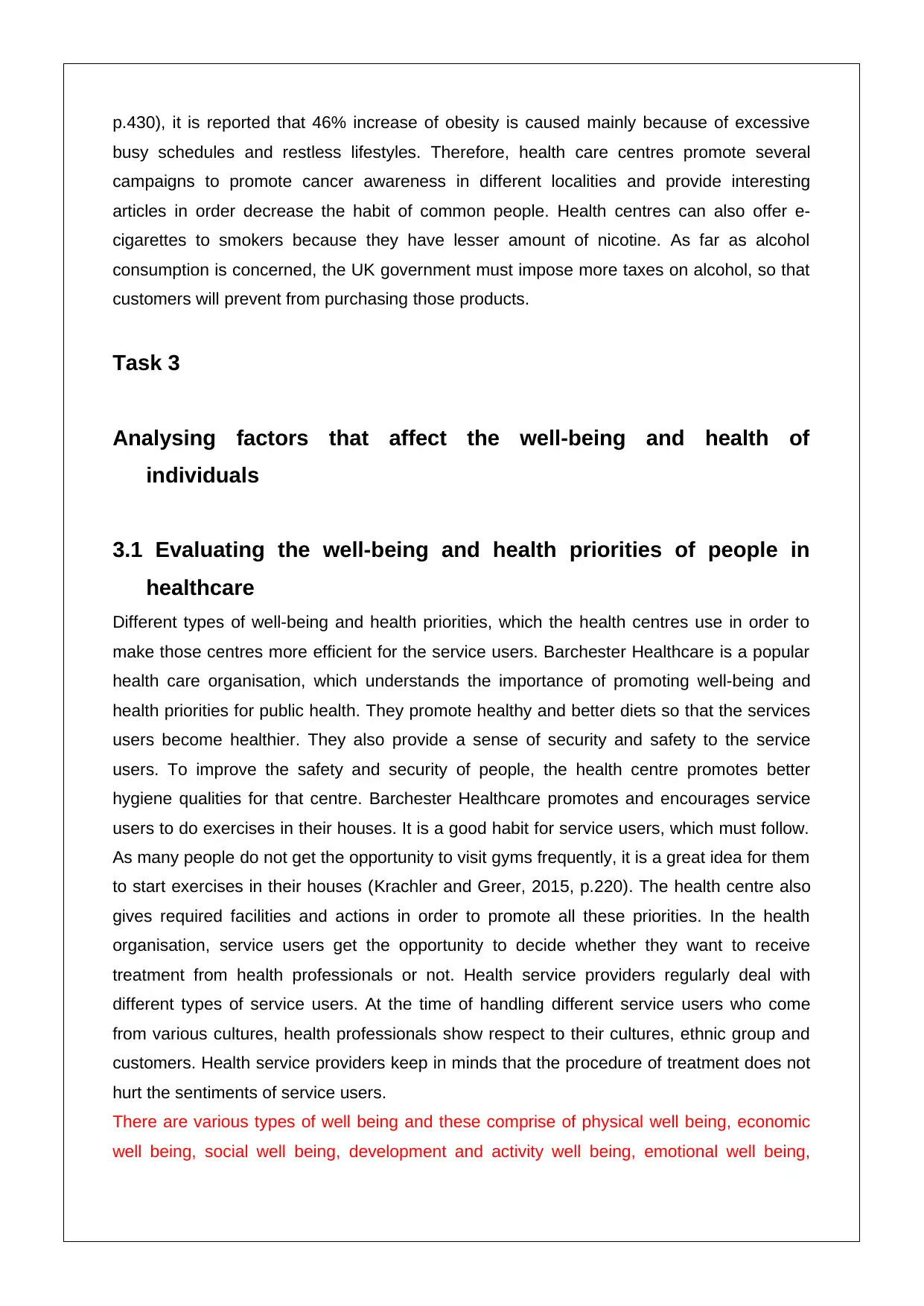
p.430), it is reported that 46% increase of obesity is caused mainly because of excessive
busy schedules and restless lifestyles. Therefore, health care centres promote several
campaigns to promote cancer awareness in different localities and provide interesting
articles in order decrease the habit of common people. Health centres can also offer e-
cigarettes to smokers because they have lesser amount of nicotine. As far as alcohol
consumption is concerned, the UK government must impose more taxes on alcohol, so that
customers will prevent from purchasing those products.
Task 3
Analysing factors that affect the well-being and health of
individuals
3.1 Evaluating the well-being and health priorities of people in
healthcare
Different types of well-being and health priorities, which the health centres use in order to
make those centres more efficient for the service users. Barchester Healthcare is a popular
health care organisation, which understands the importance of promoting well-being and
health priorities for public health. They promote healthy and better diets so that the services
users become healthier. They also provide a sense of security and safety to the service
users. To improve the safety and security of people, the health centre promotes better
hygiene qualities for that centre. Barchester Healthcare promotes and encourages service
users to do exercises in their houses. It is a good habit for service users, which must follow.
As many people do not get the opportunity to visit gyms frequently, it is a great idea for them
to start exercises in their houses (Krachler and Greer, 2015, p.220). The health centre also
gives required facilities and actions in order to promote all these priorities. In the health
organisation, service users get the opportunity to decide whether they want to receive
treatment from health professionals or not. Health service providers regularly deal with
different types of service users. At the time of handling different service users who come
from various cultures, health professionals show respect to their cultures, ethnic group and
customers. Health service providers keep in minds that the procedure of treatment does not
hurt the sentiments of service users.
There are various types of well being and these comprise of physical well being, economic
well being, social well being, development and activity well being, emotional well being,
busy schedules and restless lifestyles. Therefore, health care centres promote several
campaigns to promote cancer awareness in different localities and provide interesting
articles in order decrease the habit of common people. Health centres can also offer e-
cigarettes to smokers because they have lesser amount of nicotine. As far as alcohol
consumption is concerned, the UK government must impose more taxes on alcohol, so that
customers will prevent from purchasing those products.
Task 3
Analysing factors that affect the well-being and health of
individuals
3.1 Evaluating the well-being and health priorities of people in
healthcare
Different types of well-being and health priorities, which the health centres use in order to
make those centres more efficient for the service users. Barchester Healthcare is a popular
health care organisation, which understands the importance of promoting well-being and
health priorities for public health. They promote healthy and better diets so that the services
users become healthier. They also provide a sense of security and safety to the service
users. To improve the safety and security of people, the health centre promotes better
hygiene qualities for that centre. Barchester Healthcare promotes and encourages service
users to do exercises in their houses. It is a good habit for service users, which must follow.
As many people do not get the opportunity to visit gyms frequently, it is a great idea for them
to start exercises in their houses (Krachler and Greer, 2015, p.220). The health centre also
gives required facilities and actions in order to promote all these priorities. In the health
organisation, service users get the opportunity to decide whether they want to receive
treatment from health professionals or not. Health service providers regularly deal with
different types of service users. At the time of handling different service users who come
from various cultures, health professionals show respect to their cultures, ethnic group and
customers. Health service providers keep in minds that the procedure of treatment does not
hurt the sentiments of service users.
There are various types of well being and these comprise of physical well being, economic
well being, social well being, development and activity well being, emotional well being,
⊘ This is a preview!⊘
Do you want full access?
Subscribe today to unlock all pages.

Trusted by 1+ million students worldwide
1 out of 20
Related Documents
Your All-in-One AI-Powered Toolkit for Academic Success.
+13062052269
info@desklib.com
Available 24*7 on WhatsApp / Email
![[object Object]](/_next/static/media/star-bottom.7253800d.svg)
Unlock your academic potential
Copyright © 2020–2025 A2Z Services. All Rights Reserved. Developed and managed by ZUCOL.





